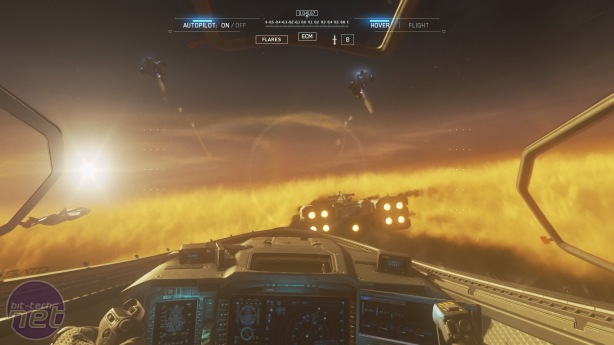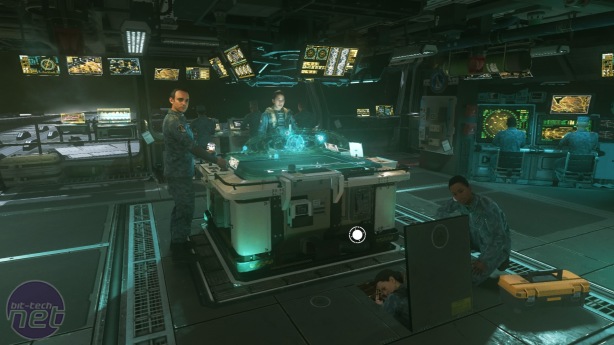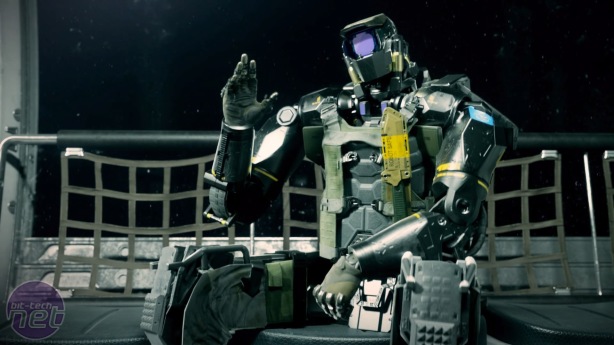Call of Duty: Infinite Warfare Review
November 10, 2016 | 14:46
Companies: #activision #infinity-ward #overwatch

While a considerable improvement over recent efforts, the campaign is not without its flaws, and there are times when the messiness of previous single-players rears its head. About a third of the way through the story, the campaign introduces a bunch of optional side-missions, which either involve infiltrating a Capital Ship for stolen weaponry, or taking on a squadron of enemy spacecraft. They’re varied and entertaining enough, but they obliterate the campaign’s earlier efforts at presenting seamless action. It’s almost like they had two separate ideas, a shooter where one mission flows neatly into the next, and a more open, Mass Effect-like structure. They then made a compromise in the middle, to the detriment of both concepts.
Moreover, as usual the story wrestles with tonal consistency, albeit less so than previous efforts. Unlike before, the game is actually aware of the questionable power dynamic between its two factions, and so overtly addresses this by putting you on the back foot. There’s even a moment when one character explicitly states, 'When did we become the underdogs?'. Even so, Call of Duty still presents a highly simplistic, one-sided view of conflict, with faceless enemies headed by an obviously psychotic leader.
Furthermore, while the voice acting is first rate and the script sharply written (including some cracking one-liners from your robotic companion Ethan), there’s a bizarre flatness to the ensuing drama. The entire story is threaded with a morbid inevitability that means when tragedy strikes (as it does frequently), it’s difficult to really care about the characters involved. Nevertheless, in the seven or eight hours that Infinite Warfare’s campaign lasts, I was never bored, and while it doesn’t quite equal the brilliance of Doom or Titanfall 2, it isn’t massively inferior either.
Sadly, the same cannot be said for Infinite Warfare’s multiplayer. Again, Infinity Ward have made attempts to innovate, but here I think they’ve been restrained by the expectations of the fanbase. The biggest change is the introduction of 'combat rigs', which are essentially classes suited to different play-styles. Each rig comes equipped with different Payloads, extremely powerful abilities that gradually charge up over the course of a match. For example, the payloads of the Warfighter (the default Assault class) include a rapid-fire, crossbow-like weapon that can bounce projectiles around corners, while the heavy 'Merc' class is granted access to armour that vaporises incoming fire. The most interesting Rig is the FTL, who can teleport short distances, and even briefly step into an alternate dimension to ambush enemies and evade attack.
Coupled with the double-jump and wall-running abilities which are apparently now standard in Call of Duty, what you’re faced with is a halfway house between Titanfall and Overwatch, a highly kinetic and acrobatic FPS with a diverse range of classes that are capable of countering each other in dozens of ways. The problem with this is that it feels like a halfway, like a game that has run out of ideas and is now simply borrowing them from elsewhere.
You can see this, too, in the multiplayer’s scattershot approach to maps and modes.
Thematically the maps are all over the place, ranging from the ice-covered corridors of Frost through the beautiful Gothic streets of Retaliation, to the futurist cityscape of Precinct. Yet the superficial themes bely the fact that most maps are highly similar networks of twisting, gunmetal corridors. These also feel extremely cramped after the airiness of Overwatch, Titanfall and Battlefield. Modes too, are all slight variations of deathmatch, domination, and capture and hold. There are seventeen modes in all, but the only one that comes close to standing out is Frontline, where larger teams of players all spawn in the same base area, and are provided with beefier health bars for longer, larger scale encounters.
What’s particularly baffling is the space theme which is so strongly emphasised in the single-player is barely evident at all in the multiplayer. You can’t leap into the cockpit of a Jackal Interceptor and go dogfighting with your mates. You can’t battle in Zero-G around the hull of a spaceship. There was a huge opportunity here to reinvent Call of Duty’s multiplayer, to make it compete with Battlefield in both in terms of scale and spectacle in a relatively unexplored setting for multiplayer shooters.
Clearly, though, there’s a strong expectation of what Call of Duty multiplayer comprises, and rather than radically change that, each iteration simply adds more stuff in. You can almost hear Infinite Warfare creaking under the weight of all the Rigs and Payloads and Unlocks and Maps and Modes. The result at the end is a brownish, nondescript midpoint between other, better multiplayer shooters.
You’ll find considerably more personality in the Zombies mode, which this year sees you and/or your mates starring in a series of 'Films' by acclaimed horror director Willard Wyler, whose pictures, it turns out, are so convincing because people really do die in them. It’s a sufficiently entertaining distraction with a surprising amount of interactivity in the environments, although I still find the mode’s zombies oddly unsatisfying to shoot.
In the end, I think Infinite Warfare is a decent shooter, but it has been unfortunate to launch in a year where several truly brilliant shooters have beaten it to the punch. Despite this, I think Infinity Ward ought to be pleased with the work it's put out, especially in the single-player campaign. Ultimately, Infinite Warfare isn’t the revolution the developers perhaps hoped it would be, but it is unquestionably a step in the right direction.
Moreover, as usual the story wrestles with tonal consistency, albeit less so than previous efforts. Unlike before, the game is actually aware of the questionable power dynamic between its two factions, and so overtly addresses this by putting you on the back foot. There’s even a moment when one character explicitly states, 'When did we become the underdogs?'. Even so, Call of Duty still presents a highly simplistic, one-sided view of conflict, with faceless enemies headed by an obviously psychotic leader.
Furthermore, while the voice acting is first rate and the script sharply written (including some cracking one-liners from your robotic companion Ethan), there’s a bizarre flatness to the ensuing drama. The entire story is threaded with a morbid inevitability that means when tragedy strikes (as it does frequently), it’s difficult to really care about the characters involved. Nevertheless, in the seven or eight hours that Infinite Warfare’s campaign lasts, I was never bored, and while it doesn’t quite equal the brilliance of Doom or Titanfall 2, it isn’t massively inferior either.
Sadly, the same cannot be said for Infinite Warfare’s multiplayer. Again, Infinity Ward have made attempts to innovate, but here I think they’ve been restrained by the expectations of the fanbase. The biggest change is the introduction of 'combat rigs', which are essentially classes suited to different play-styles. Each rig comes equipped with different Payloads, extremely powerful abilities that gradually charge up over the course of a match. For example, the payloads of the Warfighter (the default Assault class) include a rapid-fire, crossbow-like weapon that can bounce projectiles around corners, while the heavy 'Merc' class is granted access to armour that vaporises incoming fire. The most interesting Rig is the FTL, who can teleport short distances, and even briefly step into an alternate dimension to ambush enemies and evade attack.
Coupled with the double-jump and wall-running abilities which are apparently now standard in Call of Duty, what you’re faced with is a halfway house between Titanfall and Overwatch, a highly kinetic and acrobatic FPS with a diverse range of classes that are capable of countering each other in dozens of ways. The problem with this is that it feels like a halfway, like a game that has run out of ideas and is now simply borrowing them from elsewhere.
You can see this, too, in the multiplayer’s scattershot approach to maps and modes.
Thematically the maps are all over the place, ranging from the ice-covered corridors of Frost through the beautiful Gothic streets of Retaliation, to the futurist cityscape of Precinct. Yet the superficial themes bely the fact that most maps are highly similar networks of twisting, gunmetal corridors. These also feel extremely cramped after the airiness of Overwatch, Titanfall and Battlefield. Modes too, are all slight variations of deathmatch, domination, and capture and hold. There are seventeen modes in all, but the only one that comes close to standing out is Frontline, where larger teams of players all spawn in the same base area, and are provided with beefier health bars for longer, larger scale encounters.
What’s particularly baffling is the space theme which is so strongly emphasised in the single-player is barely evident at all in the multiplayer. You can’t leap into the cockpit of a Jackal Interceptor and go dogfighting with your mates. You can’t battle in Zero-G around the hull of a spaceship. There was a huge opportunity here to reinvent Call of Duty’s multiplayer, to make it compete with Battlefield in both in terms of scale and spectacle in a relatively unexplored setting for multiplayer shooters.
Clearly, though, there’s a strong expectation of what Call of Duty multiplayer comprises, and rather than radically change that, each iteration simply adds more stuff in. You can almost hear Infinite Warfare creaking under the weight of all the Rigs and Payloads and Unlocks and Maps and Modes. The result at the end is a brownish, nondescript midpoint between other, better multiplayer shooters.
You’ll find considerably more personality in the Zombies mode, which this year sees you and/or your mates starring in a series of 'Films' by acclaimed horror director Willard Wyler, whose pictures, it turns out, are so convincing because people really do die in them. It’s a sufficiently entertaining distraction with a surprising amount of interactivity in the environments, although I still find the mode’s zombies oddly unsatisfying to shoot.
In the end, I think Infinite Warfare is a decent shooter, but it has been unfortunate to launch in a year where several truly brilliant shooters have beaten it to the punch. Despite this, I think Infinity Ward ought to be pleased with the work it's put out, especially in the single-player campaign. Ultimately, Infinite Warfare isn’t the revolution the developers perhaps hoped it would be, but it is unquestionably a step in the right direction.


MSI MPG Velox 100R Chassis Review
October 14 2021 | 15:04














Want to comment? Please log in.